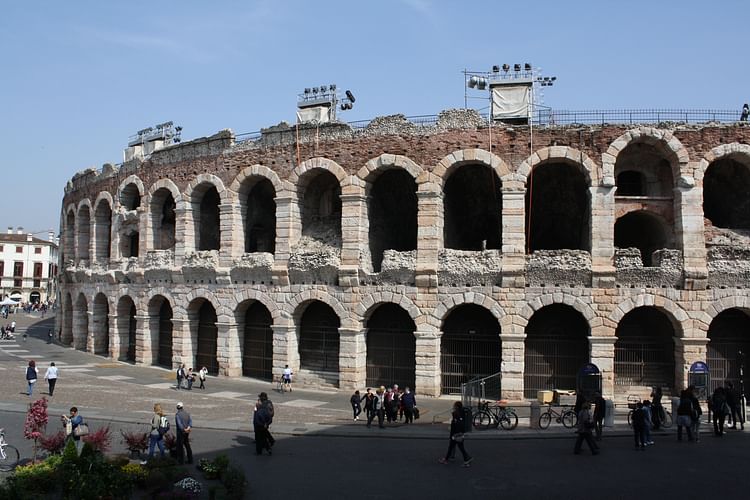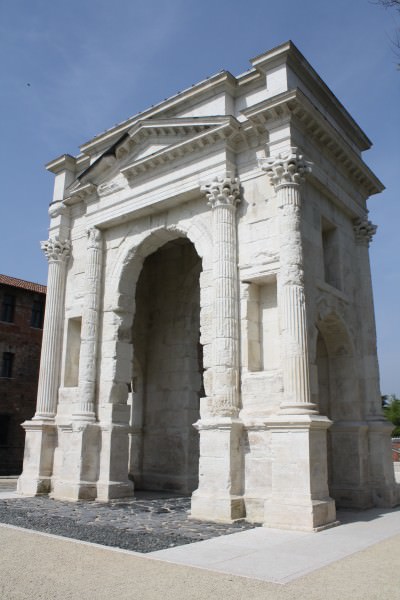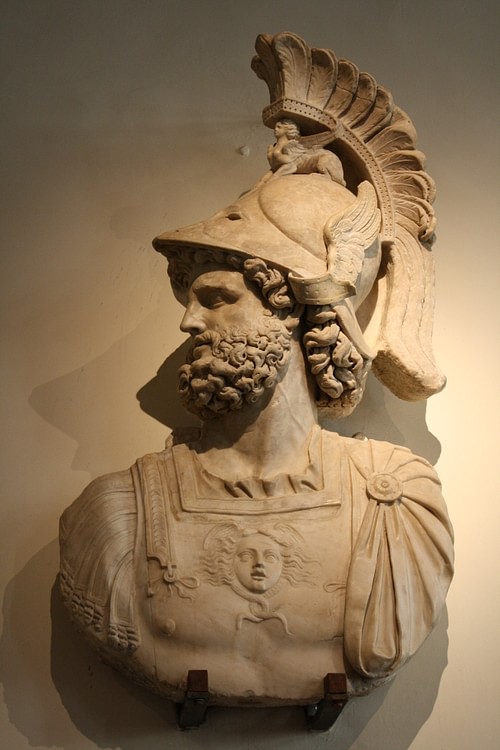Roman Verona › Antique Origins
Roman Verona
Definition and Origins

Verona, situated on the river Adige in northern Italy, was a Roman town probably founded some time in the 2nd century BCE. It was a colonia by 69 CE and the impressive monuments which survive to this day attest to the city 's importance. In late antiquity, the emperors Constantine I and Theodoric spent time in Verona, the latter building a palace, and today it is most famous for its magnificent amphitheatre, which was the third largest in the Roman world and which continues to hold important cultural events.
OVERVIEW
The oldest inscription found at Verona is from a milestone on the Via Postumia and dates to 148 BCE. The history of the town before that time is unclear but, according to both Pliny and Livy, the settlement may have been occupied by the Cenomani Gauls. Both Strabo and Martial describe Roman Verona as a large city, and prominent amongst its citizens were the powerful Gavia family who were also generous patrons of the city. In the mid-1st century CE Verona's citizens received Roman citizenship.
The general plan of the town, laid out in a regular grid pattern, may have been designed by Vitruvius. There were impressive circuit walls constructed by Emperor Gallienus (r. 253-268 CE), and notable architectural highlights include the large 1st century CE amphitheatre, several monumental gates, and a theatre. Catullus, the 1st century CE poet, is one of the town's famous sons. The town continued to be occupied through the Middle Ages but never regained the importance it had enjoyed in Roman times. The town did achieve literary fame, though, when Shakespeare chose it as a location for three of his plays, including Romeo and Juliet. Testimony to Verona's rich architectural legacy is its status as a UNESCO World Heritage Site.
ARCHITECTURAL HIGHLIGHTS INCLUDE THE LARGE 1ST CENTURY CE AMPHITHEATRE, SEVERAL MONUMENTAL GATES, AND A THEATRE.
PRINCIPAL ROMAN MONUMENTS
Amphitheatre
The 1st century CE amphitheatre, known simply as the Arena, is Verona's best preserved Roman monument. Originally there were three tiers of arches reaching a height of 30 metres, but today only two tiers survive except in one small portion where four arches survive of the top tier. The Arena floor is also now 2 metres below ground-level. The external dimensions of the elliptic structure are 152 x 123 metres, which made it the third largest Roman amphitheatre (after the Colosseum and Capua).The building was constructed using a cement and rubble mix known as opus coementicum, brick, and stone blocks from Valpolicella set in square pillars to create an external façade of 72 arches, each spanning 2 metres. These led directly to an interior corridor 4.4 metres wide which runs around the Arena. From this corridor, steps lead upwards at regular intervals and on four different levels to form vomitoria, which give access to the interior cavea. Inside, the seats were arranged in four elliptic rings giving a total of 44 rows of seats. There is also an extensive and still functioning drainage system which has contributed to the excellent preservation of the monument. The Arena was originally used to host gladiator, circus, and equestrian events and, even today, it continues to host concerts and, most famously, an opera season every summer where 20,000 spectators, as in antiquity, enjoy the unique atmosphere of an open-air spectacle.
Theatre
The Roman theatre nestling into the hill on the left bank of the Adige was first built in the 1st century BCE during the reign of Augustus with conversion to stone probably coming later. It has been partially built over on the right side but originally measured 123 x 152 metres. The semicircular cavea and stage background wall are a typical mix of Roman and Greek architecture. Once again, quality building materials and good drainage systems have allowed for a reasonable preservation and the theatre continues to be used for public performances today.

Arch of Gavi, Verona
Arch of Gavi
The arch also known as the Arco dei Gavi was built in the 1st century CE to glorify and commemorate the powerful Gavi family.Typically, triumphal arches commemorated military triumphs and statesmen, but this is a rare example of such a structure commemorating a private family. Situated to mark the beginning of the Via Sacra, the arch once had family statues in its niches, the inscriptions of which still remain. There is also an inscription: 'Lucius Vitruvius Libertus Architectus' which indicates the architect who constructed it. Beneath the arch is a well-preserved stretch of Roman road with typical polygonal slabs which show the tell-tale parallel grooves of wheeled traffic. The arch was entirely dismantled in 1805 CE when Napoleon considered that it blocked military traffic, but the arch was restored in 1932 CE.
Borsari Gate
The Borsari Gate or Porta dei Borsari was built in the 1st century CE. The gate is built from white Valpolicella stone and was the city's main entrance gate in Roman times. Two arches are flanked by engaged Corinthian columns and topped by an architrave and tympanum. Above are two tiers of smaller arches, six on each level, again with engaged columns and pediments. The inscription relates to the city walls built in 265 CE by Gallienus.

Ponte Pietra, Verona
Ponte Pietra
The bridge known today as the 'Stone Bridge' was built in the 1st century BCE and was one of only two Roman bridges that crossed the Adige. Its original name was the Pons Marmoreus. Floods, warfare, and time have taken their toll on the structure but the two arches nearest the left bank (in white) are original.
Mars › Who Was
Definition and Origins

Mars was the Roman god of war and second only to Jupiter in the Roman pantheon. Although most of the myths involving the god were borrowed from the Greek god of war Ares, Mars, nevertheless, had some features which were uniquely Roman.Considered more level-headed than the often impulsive and disruptive Ares, Mars was also seen as a more virtuous figure by the more martial-oriented Romans. As a protector of Rome and the Roman way of life and as a defender of city borders and frontiers, important festivals connected to warfare were held in his honour and the god was also closely associated with the wolf and woodpecker.
Mars was considered the father of Romulus and Remus, the mythical twin founders of Rome. According to the story, their mother, the Vestal Virgin Rhea Silvia, was raped by Mars while she slept, and in her dreams she had a vision where she dropped a hairpin to the ground, and from which there sprang two twin trees. Over time one of the trees grew so large that it covered the entire world with its shade, a reference to the ultimate success of Romulus and the growth of the huge Roman Empire.
THE MONTH OF MARTIUS (MARCH) WAS NAMED AFTER THE GOD AND IMPORTANT FESTIVALS AND CEREMONIES, USUALLY CONNECTED TO MILITARY CAMPAIGNS WERE HELD IN HIS HONOUR.
Another myth concerning the god of war, this one uniquely Roman, was his marriage to Anna Perenna. The story is re-told in Ovid 's Fasti and begins with Mars falling in love with no less a figure than Minerva, but the virgin goddess of wisdom and crafts, wholly unimpressed, rejected his amorous advances. Wondering how he could better impress Minerva and win her favour, Mars sought the help of Anna Perenna, the aged goddess of New Year and Time. However, Anna Perenna quite fancied the handsome war god for herself, and so she double-crossed Mars by disguising herself as Minerva and, wearing a veil, she tricked the god into marrying her. This famous episode of feminine guile was commemorated in Rome on the Ides of March (the 15th) when young girls would sing risqué songs.
The month of Martius (March) was named after the god. Important festivals and ceremonies, usually connected to the preparation and closure of military campaigns, were held in honour of the god in March and October and carried out by Mars' specially dedicated priests, the flamen Martialis. These rites may also have been connected to agriculture but the nature of Mars' role in this area of Roman life is disputed by scholars. The first festival of the year was actually on the 27th of February with the first Equirria, then followed a busy March. There was the feriae Marti festival, held on the 1st of March (the old New Year's Day), the second Equirria on the 14th, the agonium Martiale on the 17th, the Quinquatrus on the 19th (in later times Minerva would assume Mars' role), and the Tubilustrium on the 23rd of March (and again on the 23rd of May). The details of these festivals are sometimes sketchy, but most were related to war and the instruments of warfare. The Tubilustrium involved a series of rites to cleanse and favour trumpets, whilst the Equirria was to ensure all would be well with the horses when on campaign. Another important ritual was performed by the commander of the army about to depart who shook the sacred spears of the god which were kept in the Regia. The general shouted ' Mars vigilia ' and, no doubt, asked for a swift and easy victory.

Fresco of a Statue of Mars, Pompeii
In addition to the festivals where Mars was the central deity, he was also involved with ceremonies relating to the ancient triad of gods which included himself, Jupiter, and Quirinus. On the 1st, 9th and 23rd of March, the priests of this sacred trio, the Salii, sang hymns and dressed themselves in bronze-age armour which included the ancient ancilia figure-of-eight shields.Mars again took centre stage during the Equus October, held on the 15th of that month. This was when a great horse race was held in the Campus Martius of Rome. No doubt the winner of the race won great honour and favour amongst the public, but the fate of one of the horses of the winning team was less fortunate, for the animal was sacrificed with the head becoming a much sought-after prize by the local residents. Finally, there was the Armilustrium festival on the 19th of October, held on the Aventine and which involved the purification of weapons before they were stored away for the winter.
See other Related Contents ››
LICENSE:
Article based on information obtained from these sources:with permission from the Website Ancient History Encyclopedia
Content is available under License Creative Commons: Attribution-NonCommercial-ShareAlike 3.0 Unported. CC-BY-NC-SA License